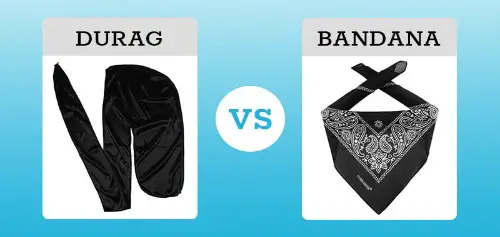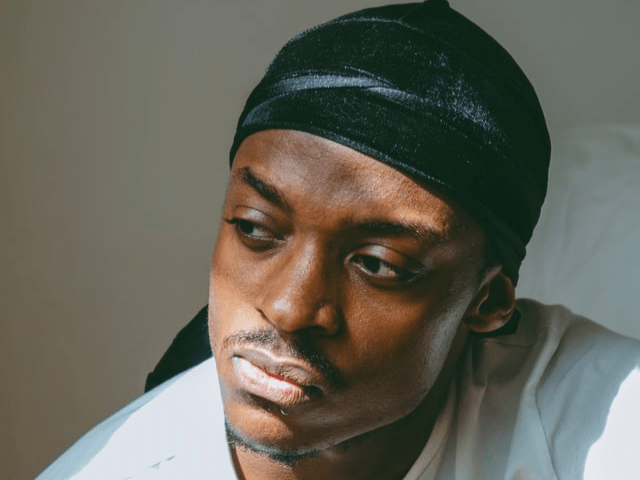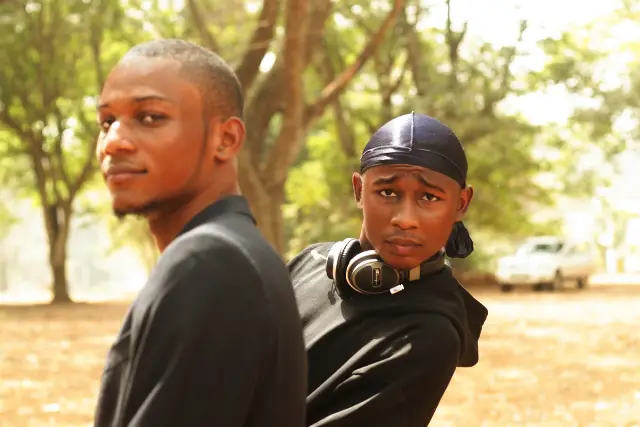The difference is in their design, fabric, and use. A durag is one accessory you can never take away from the African American community. It lays 360 waves so neat that you'll see some of them wearing a durag day and night.
What about bandanas? Where did they originate? What's indisputable so far is that bandanas make a fashion statement everywhere, not only in the U.S. Let's discover more as we delve into the durag vs. bandana debate.
Page Contents
Differences Concerning Bandana Vs. Durag As Headwear
The main differences between bandana and durag are:
- A bandana is a cotton cloth with a distinct traditional design and no tailoring pattern, whereas durag is plain-colored headwear with elaborate tailoring, including a flap and ties.
- A bandana is a plain rectangle or square cloth, whereas a durag's design is the shape of a human head.
- A bandana is versatile as you can wear it under hats, on the neck or wrist, whereas a durag covers the hair only.
- A bandana is a loose fit, whereas the best durag comes with dimensions of ties and flaps.
- A bandana's design originates from a traditional garment from India, whereas a durag's origin dates back to the cultural revolution in the U.S.
Should You Buy (Or Use) A Durag Or Bandana?
Hats protect your hair against summer heat but they don't absorb sweat. That's why most people tie bandanas or durags under them! Regardless of the reason for buying (or using) one, you are still faced with one question: "What will I buy - a durag or a bandana?"

Below are the top three reasons to help you come to terms with your durag vs bandana issue:
Shape
A doo-rag is form-fitting because it comes in the shape of your head. Its seam runs down the center to prevent those unsightly lines on your hair when you style 360s or permed hair. The ties and flap secure it so that it doesn't come off when you're sleeping or working out.
A bandana doesn't have ties; therefore, you have to struggle and tie the tiny tips at the back.
Woe unto you if your head is above average size. Also, since these head coverings aren't form-fitting, they may slip off at night.
Material
The worst thing you can do to your curly hair is wear a headscarf that increases friction! That's why many men with curly hair prefer the silk or velvet material of durags. When you wear one to bed, you wake up with neat hair as it reduces friction between your hair and the pillow.
Also, it maintains your hairstyle; thus, there's little to no combing needed in the morning. That means less hair breakage. This range of materials gives you a variety of designs for summer or winter. For instance, you can tie a mesh design in the summer heat.
Bandanas don't have such versatile materials. You get either cotton or polyester. Hence, more people use these designs as sweatbands or helmet liners.
Bikers love them because they are thin and fit snugly under helmets. Plus, the cotton material absorbs sweat.
Colors
Bandanas have at least two colors, such as black and white or blue and white; therefore, you have to tone down the rest of your outfit. The patterns also make them less formal. On the other hand, durags have one plain color without patterns. Check out the style of famous rappers like 50 Cent donning a durag. You'll even see durags worn with formal wear like suits.
Hairstyles Suited To These Accessories
If you tie a bandana over 360 waves, then you'll have an uneven pattern along the hairline, the sides, and at the back, where you'll exert more pressure as you pull the tips to the back. It's different with a durag as the ties lie flat even when worn the whole day or night.
How To Wear A Bandana Or A Durag
How To Tie A Durag
Step 1
Place the do-rag on your hair. The center seam should be symmetrical to the center of your head, and the front edge of the fabric should sit between your eyebrows and cover your hairline.
Step 2
Pull each of the two ties in each hand towards the back without covering your ears. Cross the two ties to form an X.
Step 3
Bring the two ties towards your forehead and cross them again. The X should be at the center of your forehead.
Step 4
Pull the two ties back to your head as you did in Step 2.
Step 5
Smoothen out any bumps if the do-rag isn't lying flat.
Step 6
Tie a double knot above your neck, ensuring your hair is inside the do-rag. Pull the flap down under the ties to fall over your neck.
Watch This!
How To Tie A Bandana As a Durag
Step 1
Place the headwear on your head such that the four edges fall over a different side.
Step 2
Fold the front corner inward so that its tip is pointing to your crown. It should sit across your forehead, above your eyebrows. If it sounds too complicated, place the headwear on a flat surface, and fold one corner inward. The size of the folded part depends on your head. Now, place the folded bandana on your head with the folded side falling over your forehead.
Step 3
Grab the two edges on either side of your head with each hand. So, you'll have the left and right corners in your hands.
Step 4
Pull each of these two corners towards the back of your head.
Step 5
Tie a double knot over the corner at the back of your head.
Step 6
Pull the corner at the back towards your neck so that the bandana rests tightly.
Overall, this process is similar for both accessories, only that one has a design suited as headwear, and the other will have you pulling its four edges to make a knot.
Watch This!
When you read through legal information about dress codes and hairstyles, you find dozens of articles about durags and bandanas banned in schools, sports stadia, and sports teams. There's still a lot of misunderstanding about these accessories.
Now, let's look at some answers to your burning questions.
Frequently Asked Questions
Can you wear a bandana as a durag?
Yes, of course, and there's a reason people choose durags instead of bandanas but you can improvise when you don't have a durag. You'll have to adapt it to the task at hand using the method mentioned above, where you fold one side to form a triangle out of the square fabric.
Before choosing a durag or bandana, consider why you want to wear one. If you're wearing it as a fashion item, it's okay. However, if there's an issue with frizz and breakage, don't substitute a durag. Either way, you don't have to worry about durags causing hair loss.
Bandanas are from what cultures?
Their origin is India, where locals wore brightly-colored silk or cotton handkerchiefs called bandhani on their heads or necks as fashion items. The word Bandhana means a bond in Sanskrit.
What's the point of a durag?
Black men prefer wearing a durag to protect their tresses at night. That's why this accessory is so popular among men with 360 waves. In addition to preventing fiction, it also reduces frizz. Some men wear durags to keep away loose tresses off their faces during workouts.
Are bandanas still in style in 2024?
Their popularity waned around 2008 but bandanas made a comeback and are now fashionable items again. The difference between then and now is that there's more color variety -- even when you want to go on a fashion adventure by wearing bold colors like yellow or pink.
Conclusion
You'll come across people wearing bandanas or durags to tame their hair, make a fashion statement, or keep warm. These are versatile fashion items worn across the world. However, there are a few similarities as there are differences in their designs and functionality.
The main difference between a durag and a bandana is the former serves as a wave cap while the latter adds style. Additionally, bandanas don't come in velvet and silk.



